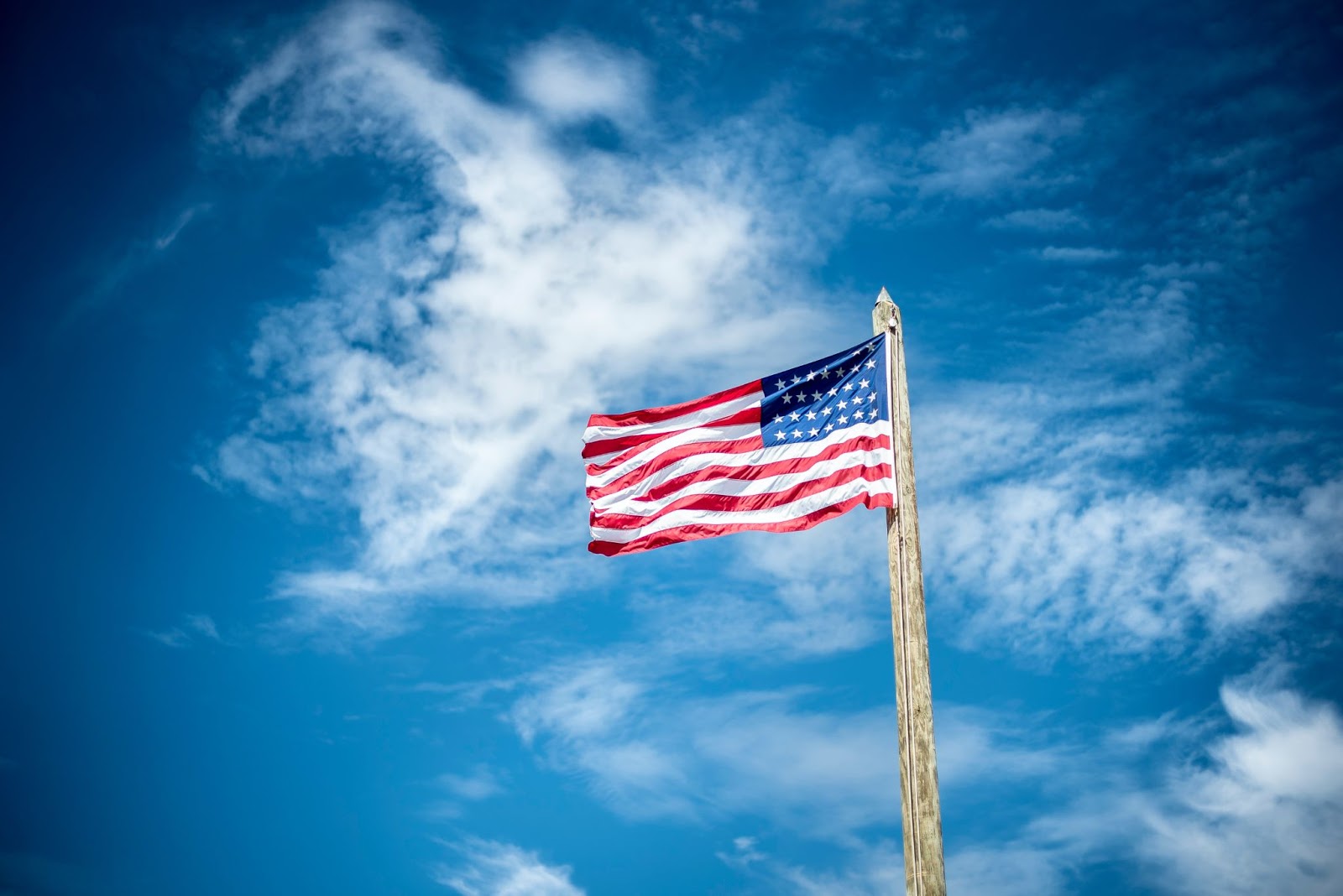kaDespite what popularized myths indicate, the American flag colors (red, white, and blue) were not chosen for any specific reason in America in 1777. America inherited the colors from the flag of Great Britain. However, Charles Thompson, secretary of the Continental Congress, gave specific meaning to the colors represented in the United States Great Seal.
Charles Thompson noted these representations:
- White stripes represent “purity and innocence.”
- Red stands for “hardiness and valor.”
- Blue represents the United States’s “vigilance, perseverance, and justice.”
Though there is no official meaning to the American flag’s color, people generally refer to Thompson’s description for their meaning.
If we look deeper into the context of red, white, and blue, we can find even more powerful symbolism within our nation’s flag.
Red
The red in our modern American flag design is called Old Glory Red. A fitting title, we know.
Red is a color used as a signifier in many great works of literature and pieces of art. Generally, red expresses excitement, energy, desire, and all things intense and passionate. Red is also used to signify danger.
The symbolic gesture behind the use of red in the American flag falls in line with the meanings mentioned above. It signifies hardiness and valor. Valor means great courage in the face of danger, especially in battle. This definition is comparable to the historical and literary context of the color.
White
The white in the pales of the American flag represents innocence and purity.
We can make even more sense of this by considering the delicate nature of the color. On the flag of the United Kingdom, the white is known to represent the cross of St. Andrew. The death of a saint, a pure and innocent individual, can be easily inferred through this deliberate color choice.
Blue
The name of the blue used on the American flag is called Old Glory Blue. Blue can signify peace, happiness, relaxation, and comfort. While blue can have negative connotations of sadness in other circumstances, the blue used in the American flag represents justice, perseverance, and vigilance.
Blue is a stoic color. It reminds us of the ocean and the sky. We see it every day when we walk outside.
The reason blue signifies justice in the American flag is because it is a pillar of our democracy. America does not function without the justice system. Modernly, Americans value justice for many reasons. Economic equality, educational opportunities are all strengths gained through the American justice system.
Perseverance is another aspect of the color’s symbolism in the flag. Despite opposition, failure, and difficulties, we as American citizens are expected to keep pushing forward.
Last but not least, blue stands for vigilance in regards to the flag. Being vigilant means staying determined and focused over prolonged periods of time. It’s our responsibility to keep our eyes on the prize and never allow the ideals of America to be forgotten.
Other That Countries Utilize Red, White, And Blue In Their Flag
America is not the only national flag composed of red, white and blue; there are 20 other nations with the same color scheme. French, Chilean, and Croatian flags have the same colors. So, what do the colors mean to those countries?
France’s Flag
France was our main ally in the fight against the British during the Revolutionary War, so we might assume that our flag is a homage to them as well. The French Tricolor, which transitions from blue to white to red coming off the flagpole, is deeply entrenched with their history.
The white color is a tribute to the House of Bourbon, who were the rulers from the 16th century until they were ousted in the French Revolution (1789 to 1799).
Blue and red were the favorite colors of the Revolutionaries and were tied to France’s long and storied past.
It is often said that the French took inspiration from the Netherlands, which sported a similar flag during the 17th Century.
Chile’s Flag
The design of the Chilean flag displays a red, white and blue banner with a white star in the blue region. Their use of the colors pays tribute to their physical environment. The blue in Chile’s flag represents the sky. At the same time, the white is there to remind its citizens of the snow of the Andes mountains. Red represents the blood spilled in battle while fighting for freedom. The single star on their flag represents their government’s power.
Croatia’s Flag
In the mid-19th century, Croatia was under Hungarian rule. In 1848, Croatians tried to revolt, and they picked a flag to represent their cause. The colors on the flag are red, white, and blue. They were inspired by the flag of imperial Russia (an enemy of Austria-Hungary and a possible Croatian ally). The Croatians failed to obtain their independence through the revolt, but the flag remained a symbol of hope for their freedom.
In 1941, a historical shield of Croatia was added to the flag (a red and white checkerboard). Today, the national flag of Croatia is the same design that was officially adopted in December 1990. The modern flag shows the stripes and the shield of Croatia as well as a “crown” encompassing five shields from the Croatian past. These shields are Istria, Slavonia, Dalmatia, and Dubrovnik.
The Thirteen Stripes
Now that we have broken down what the colors represent on the flag, let’s dive into the other elements on the flag. The thirteen stripes on the American flag represent the thirteen original colonies of Connecticut, Delaware, Georgia, Maryland, Massachusetts, New Hampshire, New Jersey, New York, North Carolina, Pennsylvania, Rhode Island, South Carolina, and Virginia.
Seven red stripes are alternating with six white stripes - red on top and bottom. The stripes are of equal width and run horizontally.
Rumors suggest two flags were designed, one for the Navy and one for the U.S government. The difference between the flags was the order of the stripes. The naval flag ordered the red stripe first, while the government flag started with a white stripe. Red eventually took its place on top and bottom for practical reasons -- white shows more wear and tear.
Fifty Stars
The fifty white stars on the American flag represent each of the country's fifty states. As the number of stars changed with the addition of new states, so did the arrangement of the stars on the flag.
The current arrangement is nine rows—the rows alternate between six stars in a row and five stars in the row beneath.
Are you curious about how the modern design came to be? In 1958, Robert Heft was a junior in high school. The stars of Alaska and Hawaii were new additions to the flag, and the government was accepting design submissions. Robert Heft’s history teacher assigned his class a project to demonstrate their American History interest. Heft decided to turn in a design of the American flag that included fifty stars. His teacher graded his assignment a B minus for it “lacked imagination.”
The high schooler’s mock-up of the flag was sent to the White House and was chosen as the official design of the American flag we know and love today. Heft’s design beat out over 1,500 submissions.
Looking For A Flag Of Your Own?
Allegiance Flag Supply can provide you with a durable flag to suit all of your patriotic display needs. They offer flags that are as strong as the United States Military. You won’t have to worry about quick deterioration with Allegiance Flag Supply products!
That’s All, Folks
If we learned anything here today, it’s that the colors of the American flag are meant to instill a central thread through Americans to unify us as a group. Red is used to capture the feeling of courage. White represents innocence and purity, and blue is for justice and hope.
There are few things more sacred than the American Flag. It’s a flag that represents a people, a movement, and should always be a product of both, made and flown by proud Americans.
We hope this helped you learn what the American flag colors represent, and you’ll take an extra minute to appreciate it the next time you see the ol’ red, white, and blue stand in the wind.
Sources:
Flag of the United Kingdom | Britannica
Great Seal of the United States | Facts, History, & Symbolism | Britannica
French Revolution: Timeline, Causes & Summary | HISTORY





